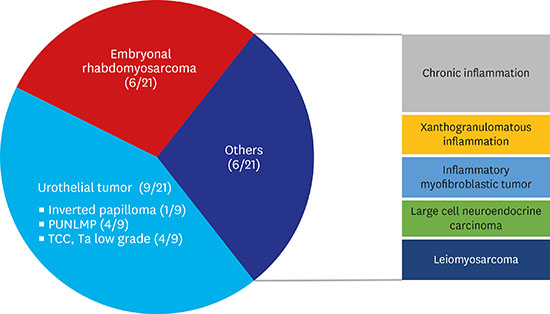1. Kutarski PW, Padwell A. Transitional cell carcinoma of the bladder in young adults. Br J Urol. 1993; 72(5 Pt 2):749–755.

2. Javadpour N, Mostofi FK. Primary epithelial tumors of the bladder in the first two decades of life. J Urol. 1969; 101(5):706–710.

3. Paner GP, Zehnder P, Amin AM, Husain AN, Desai MM. Urothelial neoplasms of the urinary bladder occurring in young adult and pediatric patients: a comprehensive review of literature with implications for patient management. Adv Anat Pathol. 2011; 18(1):79–89.
4. Stanton ML, Xiao L, Czerniak BA, Guo CC. Urothelial tumors of the urinary bladder in young patients: a clinicopathologic study of 59 cases. Arch Pathol Lab Med. 2013; 137(10):1337–1341.

5. Alanee S, Shukla AR. Bladder malignancies in children aged <18 years: results from the Surveillance, Epidemiology and End Results database. BJU Int. 2010; 106(4):557–560.
6. Wang ZH, Li YY, Hu ZQ, Zhu H, Zhuang QY, Qi Y, et al. Does urothelial cancer of bladder behave differently in young patients? Chin Med J (Engl). 2012; 125(15):2643–2648.
7. Park S, Kim KS, Cho SJ, Lee DG, Jeong BC, Park KH, et al. Urothelial tumors of the urinary bladder in two adolescent patients: emphasis on follow-up methods. Korean J Urol. 2014; 55(6):430–433.

8. Yoon JH, Ahn YH, Chun JI, Park HJ, Park BK. Acute Raoultella planticola cystitis in a child with rhabdomyosarcoma of the bladder neck. Pediatr Int. 2015; 57(5):985–987.

9. Kang DI, Jung S, Kim SC. Papillary urothelial neoplasm of low malignant potential in a child. Korean J Pediatr Urol. 2013; 5(1):5–7.
10. Choi S, Yoon JB. Transitional cell carcinoma of the bladder in patients 40 years old or less. Korean J Urol. 1988; 29(6):903–908.
11. Kim WJ, Lee SE, Kim YK. Transitional cell carcinoma of the bladder in the first three decades of life. Korean J Urol. 1986; 27(2):255–258.
12. Seon YB, Kim JH, Kwon SS, Kim YH, Park HJ, Kwon CH, et al. Two cases of transitional cell carcinoma of the bladder in patient younger than 20 years old. Korean J Urol. 1998; 39(3):283–285.
13. Koh JE, Kweon KW, Koh ES, Lee KW, Kim JM, Kim YH, et al. Urothelial carcinoma in a 17-year-old boy. Korean J Urol. 2008; 49(2):190–192.

14. Eble JN, Sauter G, Epstein JI, Sesterhenn IA. Pathology and genetics of tumours of the urinary system and male genital organs. World Health Organization Classification of Tumours. Geneva: World Health Organization;2004. p. 89–123.
15. Lawrence W Jr, Gehan EA, Hays DM, Beltangady M, Maurer HM. Prognostic significance of staging factors of the UICC staging system in childhood rhabdomyosarcoma: a report from the Intergroup Rhabdomyosarcoma Study (IRS-II). J Clin Oncol. 1987; 5(1):46–54.

16. Williamson SR, Lopez-Beltran A, MacLennan GT, Montironi R, Cheng L. Unique clinicopathologic and molecular characteristics of urinary bladder tumors in children and young adults. Urol Oncol. 2013; 31(4):414–426.

17. Nomikos M, Pappas A, Kopaka ME, Tzoulakis S, Volonakis I, Stavrakakis G, et al. Urothelial carcinoma of the urinary bladder in young adults: presentation, clinical behavior and outcome. Adv Urol. 2011; 2011:480738.

18. Wen YC, Kuo JY, Chen KK, Lin AT, Chang YH, Hsu YS, et al. Urothelial carcinoma of the urinary bladder in young adults--clinical experience at Taipei Veterans General Hospital. J Chin Med Assoc. 2005; 68(6):272–275.
19. Fine SW, Humphrey PA, Dehner LP, Amin MB, Epstein JI. Urothelial neoplasms in patients 20 years or younger: a clinicopathological analysis using the world health organization 2004 bladder consensus classification. J Urol. 2005; 174(5):1976–1980.

20. Greenfield SP, Williot P, Kaplan D. Gross hematuria in children: a ten-year review. Urology. 2007; 69(1):166–169.

21. Ander H, Dönmez MI, Yitgin Y, Tefik T, Ziylan O, Oktar T, et al. Urothelial carcinoma of the urinary bladder in pediatric patients: a long-term follow-up. Int Urol Nephrol. 2015; 47(5):771–774.

22. Hays DM, Raney RB Jr, Lawrence W Jr, Soule EH, Gehan EA, Tefft M. Bladder and prostatic tumors in the intergroup Rhabdomyosarcoma study (IRS-I): results of therapy. Cancer. 1982; 50(8):1472–1482.

23. Arndt C, Rodeberg D, Breitfeld PP, Raney RB, Ullrich F, Donaldson S. Does bladder preservation (as a surgical principle) lead to retaining bladder function in bladder/prostate rhabdomyosarcoma? Results from intergroup rhabdomyosarcoma study iv. J Urol. 2004; 171(6 Pt 1):2396–2403.

24. Lerena J, Krauel L, García-Aparicio L, Vallasciani S, Suñol M, Rodó J. Transitional cell carcinoma of the bladder in children and adolescents: six-case series and review of the literature. J Pediatr Urol. 2010; 6(5):481–485.

25. Ferrer FA, Isakoff M, Koyle MA. Bladder/prostate rhabdomyosarcoma: past, present and future. J Urol. 2006; 176(4 Pt 1):1283–1291.

26. Seitz G, Dantonello TM, Int-Veen C, Blumenstock G, Godzinski J, Klingebiel T, et al. Treatment efficiency, outcome and surgical treatment problems in patients suffering from localized embryonal bladder/prostate rhabdomyosarcoma: a report from the Cooperative Soft Tissue Sarcoma trial CWS-96. Pediatr Blood Cancer. 2011; 56(5):718–724.
















